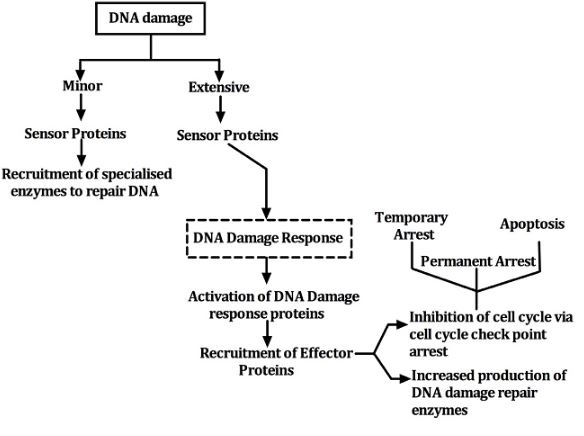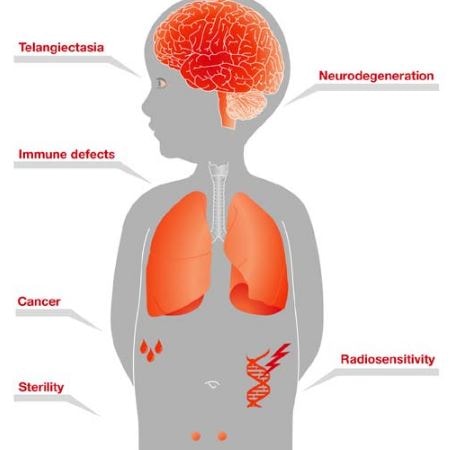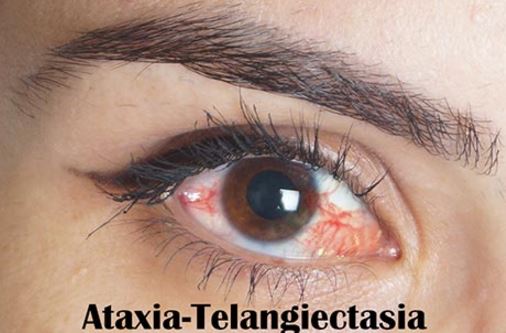Ataxia Telangiectasia
What is Ataxia Telangiectasia (AT)?
Ataxia Telangiectasia is the term which is derived from two clinical presentations: Ataxia- body coordination disorder during walking; Telangiectasia- enlargement of the blood vessels, which is visible through the skin.
The incidence of ataxia telangiectasia is infrequent, however, the onset of this condition is appeared in childhood due to immunodeficiency disorder. Multiple organ, including the brain is affected due to immunodeficiency disorder. Ataxia telangiectasia is an gradually deteriorating nervous system disorder. Recessive genetic disorder is the cause of the ataxia telangiectasia. (1,2)

Symptoms
In this section all the associated clinical presentation of the ataxia telangiectasia is mentioned, but it is not necessary that all the mentioned symptoms are noticeable for every case, as the symptoms occurrence varies from individual to individual.

Coordinated difficulty during the movement of the body (Ataxia)
The main clinical feature of the AT is ataxia and as it develops in early childhood, therefore, at the initial stage ataxia may be describe an anomalous quiver of the head and upper body part. With increasing age, progressive abnormality leads to walking difficulty and even a child cannot walk at late childhood or teens.
If the child can walk, but their walking posture is abnormal like a peculiarly curved posture and unbalanced, fast, erratic movement or tremor that may arise in association with comparatively sluggish, writing activity.
Apart from walking difficulty, ataxia also influence speaking difficulty, salivating, uncontrolled eye movement.
Oculomotor apraxia (uncoordinated eye movement) can also illustrate by the incidence of spontaneous, fast, recurring movements (oscillations) of the eyes during providing effort to focus upon exact point.
Telangiectasia
The characteristic feature of the telangiectasia is dilated blood vessels, which appears as a reddish, tiny, spider-like veins. This is usually noticeable at the mid-childhood, frequently become visible on sun-exposed parts of the skin, which include the ears, the bridge of the nose, and some areas of the limbs and also in the conjunctiva (mucous membranes of the eyes). Sporadic nosebleed may also happen.

Cognitive development
Ataxia Telangiectasia usually does not influence cognitive development, most of the affected children show standard or more than average aptitude.
Physical development
Deficiency of growth hormone can cause growth retardation. Almost 90% of the affected people with AT have premature aging symptoms. At the teenage, affected adolescent frequently have a gray hair, skin texture become thin, dry, wrinkled or discolored. Other than these, several skin problems are also associated with skin or hair related. The incomplete genital organ development also occurs in both the genders due to endocrinal abnormalities which leads to hormonal misbalance.
Immunity related problem
Immunodeficiency is a common association with AT, which increases the susceptibility towards infections, such as persistent sinusitis and/or infections in lungs, frequent pneumonia attacks and unrelieved bronchitis.
Cancer
Almost 1/3rd patients with AT have the tendency to develop cancer or benign tumor at the early adulthood. The probability of certain malignancies, such as lymphomas (cancer in lymph nodes and vessels) or leukemia (blood cancer) is more in the individuals having AT. X-ray exposure increases the incident rate of the tumors.
Some individuals act as a carrier of the ataxia telangiectasia, as they have one responsible gene, and it has been seen that they are having a higher possibility for cancer development than the general population. (2, 3, 4)
Diagnosis
The initial diagnosis of ataxia telangiectasia is based on detailed knowledge of the patient history, which is then followed by a detailed clinical assessment, detection of typical symptoms, and a multiple specific tests, Which include hematologic tests, MRI (magnetic resonance imaging), and karyotyping.
Usual finding in laboratory report for hematologic tests is elevated levels of serum alpha-fetoprotein, but in some cases, normal children may also have elevated levels of serum alpha-fetoprotein at their first 2 years of age. In addition, hematologic test reports also have elevated level of liver enzymes. The MRI report revealed cerebellar atrophy, which is detectable due to producing cross-sectional images of the brain.
The specialized test like Karyotyping conduction helps to find out the chromosomal abnormalities. Chromosomal abnormality is an usual findings of individuals who have ataxia telangiectasia. (1,3)
Treatment
There is no curative treatment is available for treating the ataxia telangiectasia. The treatment is mainly provided to control the discomfort associated with the occurrence of symptoms.
- Antibiotics are prescribed for respiratory infection. In severe cases, postural drainage is applied to expel the fluid from the bronchial tubes and lungs. In some cases gammaglobulin injections are provided for the betterment of the immune system.
- It is always recommended to avoid direct sun exposure for AT affected individuals, which may play a role to restrict the severe dilation of the blood vessels. For skin and hair problem, vitamin E may apply, but it is always advisable to consult a physician before administering any therapy to avoid toxicity.
- Diazepam (Valium) medicine may be beneficial for controlling garbled speech and involuntary muscle contractions.
- For preventing abnormal curving of the extremities and to improve the muscle strength, physical therapy may be applied.
- Infection control care is needed, as most of the affected individuals have immunodeficiency.
- The other supportive treatment regimens are applied according to the patient need.
- Genetic counseling often assists to people having AT and their families.(3,4)
Life expectancy
Individuals with ataxia telangiectasia have a variable life expectancy. Children who have AT are generally restricted to a wheelchair at 10 years of age and usually don’t stay alive till their teens. (1)
References
- Ataxia-telangiectasia; Genetic Home Reference; Retrieve from: https://ghr.nlm.nih.gov/condition/ataxia-telangiectasia
- Chad Haldeman-Englert, (2015); Ataxia – telangiectasia; Retrieve from: https://www.nlm.nih.gov/medlineplus/ency/article/001394.htm
- Ataxia Telangiectasia; National Organization for Rare Disorders; Retrieve from: http://rarediseases.org/rare-diseases/ataxia-telangiectasia/
- Ataxia-Telangiectasia; Immune Deficiency Foundation; Retrieve from: http://primaryimmune.org/about-primary-immunodeficiencies/specific-disease-types/ataxia-telangiectasia/
